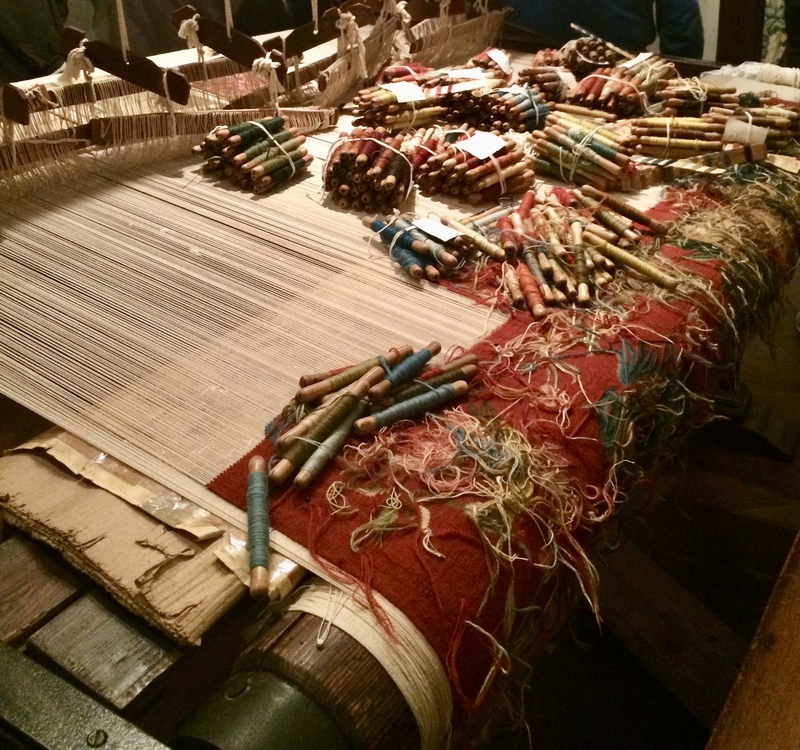Introduction to tapestry
In this series, we will present chosen works from the Akershus Castle’s tapestry collection. We start by taking a closer look at tapestry production, and the golden age.

In this series, we will present chosen works from the Akershus Castle’s tapestry collection. We start by taking a closer look at tapestry production, and the golden age.
Tapestry is a textile art form that has been practised all over the world for thousands of years.
It flourished in Europe from the Middle Ages and onwards, where you would find tapestries as wall hangings in all elite residences. Tapestries added colour and kept the draught out. They added entertainment, as the stories depicted were usually collected from well-known sources of the Bible, mythology or the classics, and contemporary events. Tapestries could be taken down, rolled together and brought to the owners' other residences or maybe even out in the field put up on display in the King's tent. Tapestries were (and are) extraordinary costly and would reflect the owner's wealth, thus used as a status symbol. The more, the merrier!
Tapestries are woven pieces of art in its highest form. They are usually woven on a woollen warp, stretched on a loom. The loom can either be a vertical high-warp loom (lisse Haute) or horizontal low-warp loom (lisse base). Weavings made on a low warp loom would have the back-side facing the weaver. The finished product would be a mirror image of the pattern.
The weaver would create the motive with dyed threads between the warps in the loom. Not weaving the thread all the way through the warp, but only where that particular colour or shade is needed. Mostly silk would be used to make the most impressive and costly pieces. The most valuable tapestries also included metal-thread in gold or silver to add even more to the exclusivity and make the tapestry sparkle and shine.

To model a depiction woven with thread, you would need all colours in all shades. You would also need a safe and rich supply of such; hence, the close link between the spinning and dyeing industry to tapestry production.
Tapestry weaving is labour-intensive and could take months. The big professional workshops employed several skilful weavers working on the same piece or set. In the workshops, weavers would specialise in, for example, weaving human figures, plants or animals. It was also common for individual workshops to cooperate in producing larger sets or series of tapestries.
Usually, the factories employed an artist to make the designs (Modello) and the cartons. The carton is a full-size drawing or painting as a pattern for the tapestry. Cut into strips it would fit under the loom for the weavers to look at as they weave. The Cartons could be used multiple times and were valued as they could be sold and traded between the different weavers and workshops.
In the 16th and 17th-century tapestry weaving was common in all Europe. But the absolute centre of production of high-end tapestries and where you would find the most skilful weavers were in France and Flanders (today Belgium) in cities like Brussels, Antwerp, Oudenaarde and Ghent. In this area and especially in Brussels, the infrastructure supplying each leg of the production was specialised and professionalised into perfection. The supply of thread, dyeing, skilful weavers, artists, cartons, and looms to the agents selling the finished products from workshops.
Production of exclusive tapestries in other countries mostly relied on emigrated weavers from Flanders. At the end of the 16th century and beginning of the 17th century, turbulent times forced many weavers to flee persecution for their religious beliefs, to much delight for the sovereigns who offered them a safe harbour in return for production of tapestries. For example, Mortlake, England and Gobelin, France initially relied on weavers from Flanders.
An example from Scandinavia is in 1577 when the Danish-Norwegian king Frederik II employed the artist Hans Kneiper from Flanders to set up a weaving workshop near Kronborg Castle, Denmark. The workshop produced a number of works for the king and employed over 20 people.
Campbell, Thomas P. Edt. Tapestry in the Baroque: Threads of Splendour, New York: The Metropolitan Museum of Art, Yale University Press, New Haven and London, 2007.
d’Hulst, Roger-A. Flämische Bildteppiche. Brüssel: Kunstverkag LArcade, 1961.
Delmarcel, Guy. Flemish Tapestry. New York: Harry N. Abrahams Inc, 2000.
Elizabeth Cleland, ‘'Throne Baldachin'', in: Thomas P. Campbell (ed.), Tapestry in the Baroque: Threads of Splendor. New York: The Metropolitan Museum of Art, Yale University Press, New Haven and London, 2007.
Read more about tapestry in this article by the Victoria and Albert Museum